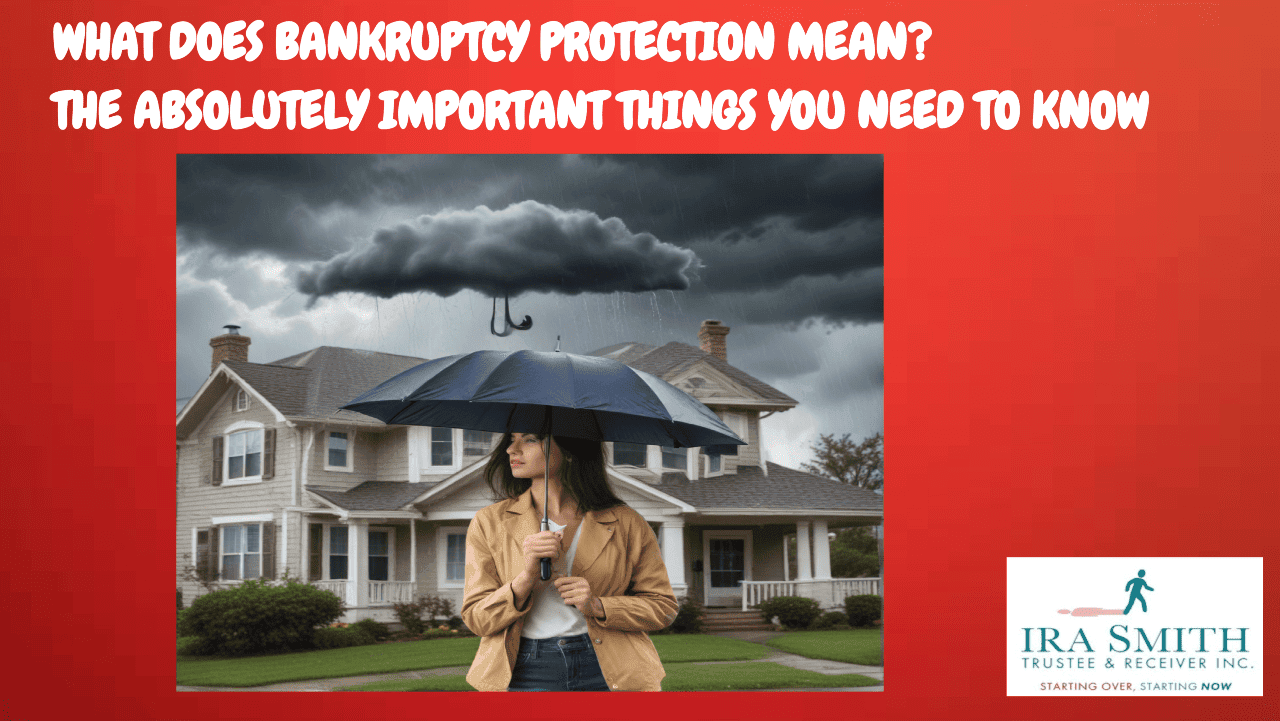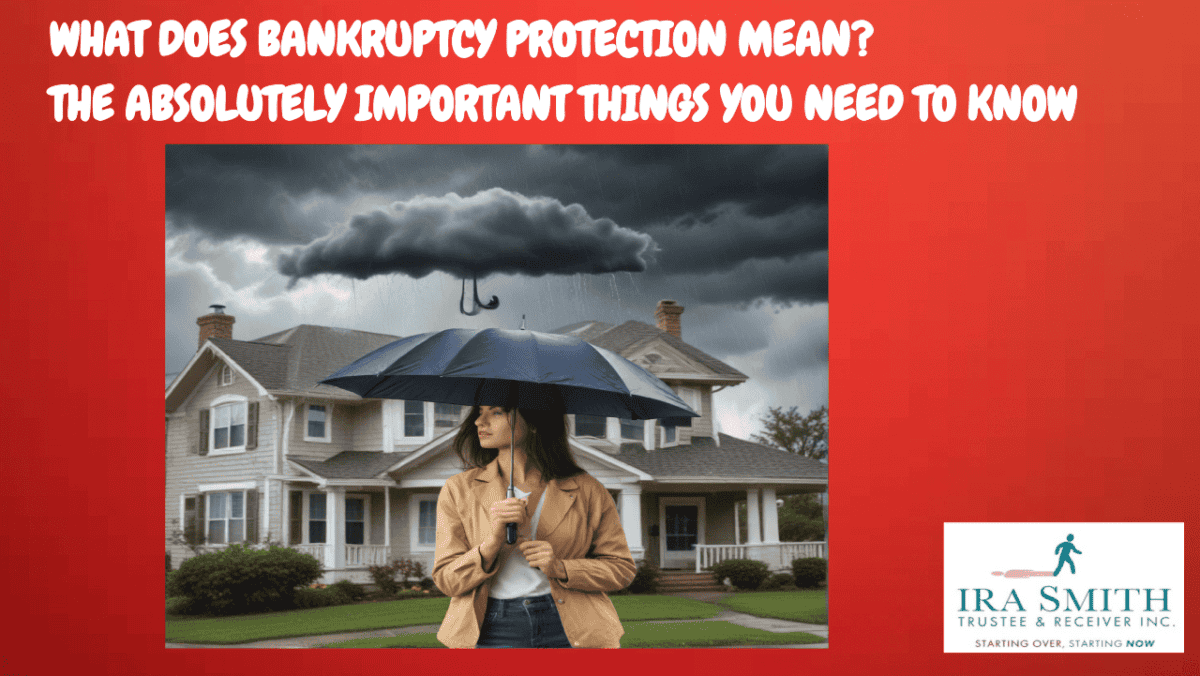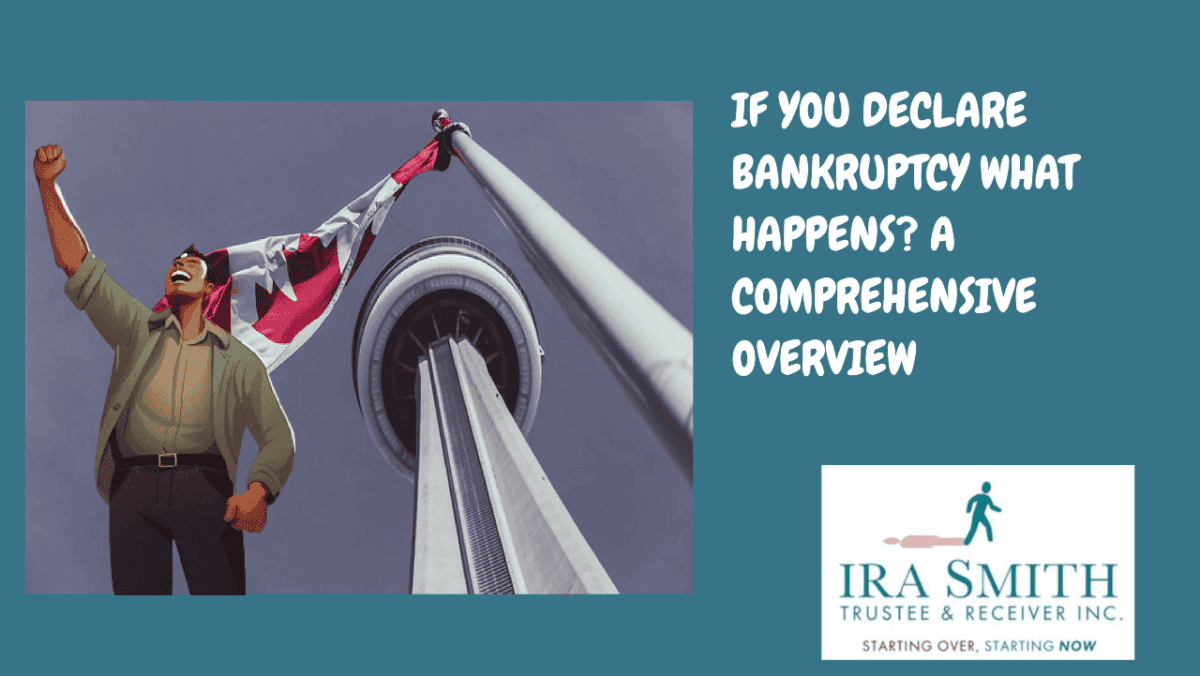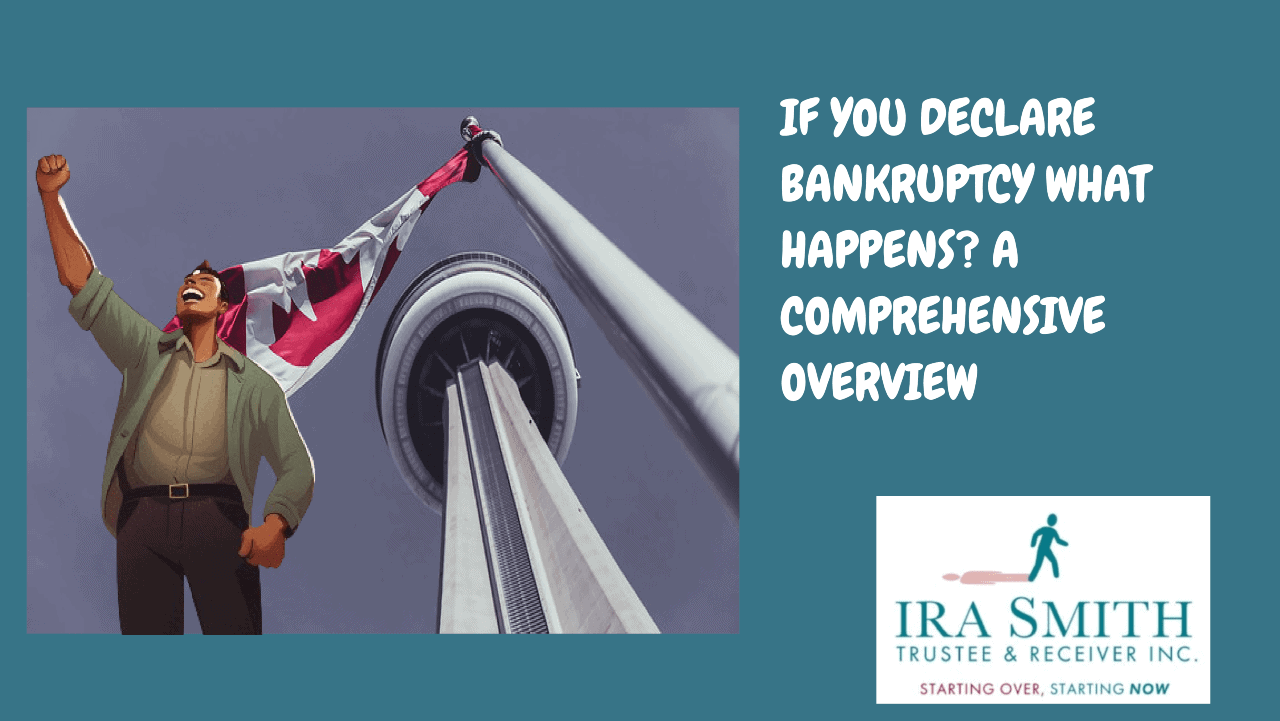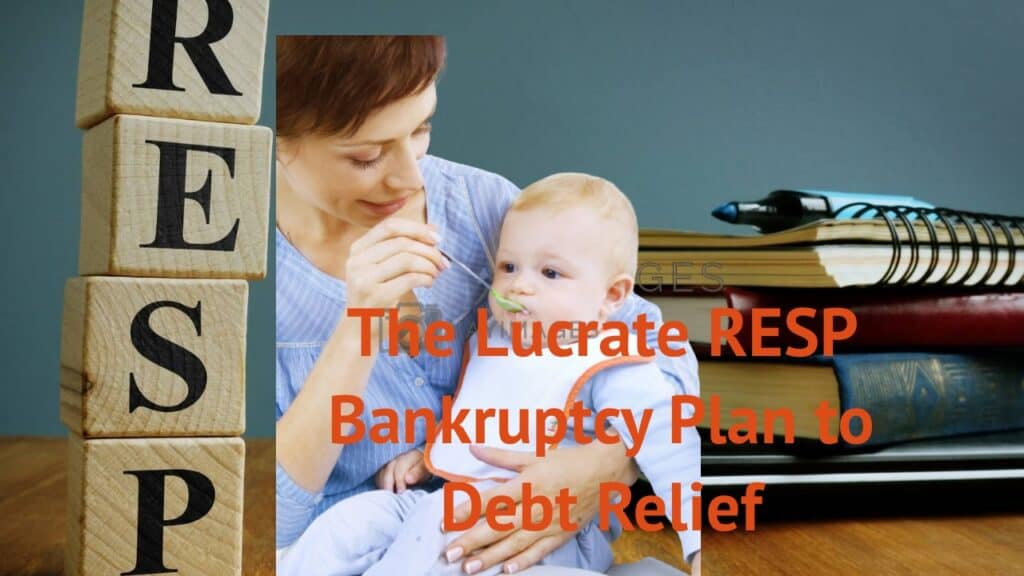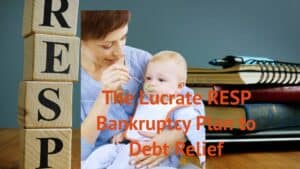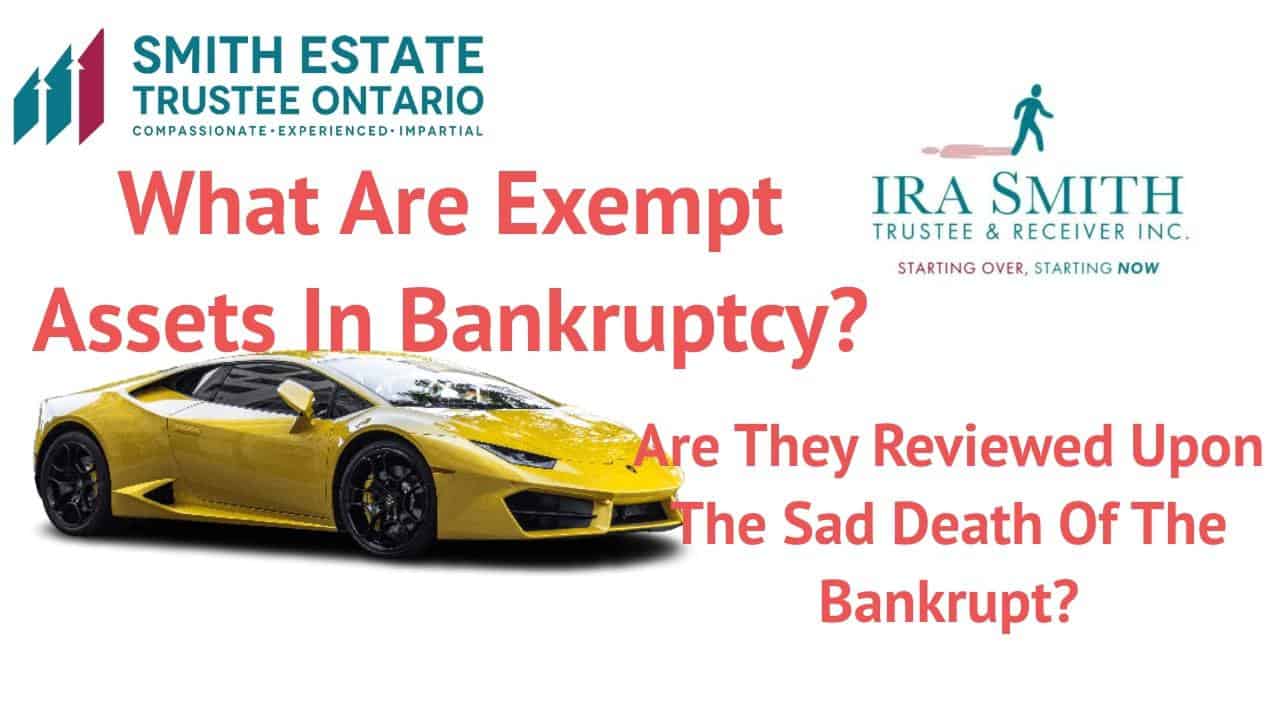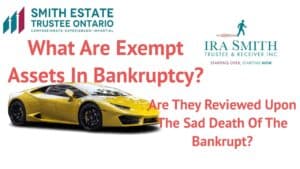what does bankruptcy protection mean
What does bankruptcy protection mean? Canada’s Bankruptcy & Insolvency Act
What does bankruptcy protection mean? Bankruptcy protection is a legal status granted to individuals or businesses under Canada’s Bankruptcy and Insolvency Act (BIA). This protection shields debtors from creditor actions while working towards a fresh financial start, whether through bankruptcy or a consumer proposal.
Common questions are:
- How does bankruptcy protect my assets?
- What is the difference between a Consumer Proposal and bankruptcy?
- How does bankruptcy protect my income?
- Can I file for bankruptcy if I have no assets or income?
- What happens to my debts after bankruptcy?
- Do I need a bankruptcy lawyer to file for bankruptcy?
In this Brandon’s Blog, I demystify the concept of bankruptcy protection, shedding light on its significance and the various forms it can take. I answer these and other questions to explain “What Does Bankruptcy Protection Mean?“.
What Does Bankruptcy Protection Mean? Legal Framework of Bankruptcy Protection
The legal framework of bankruptcy protection is rooted in the BIA in Canada. This act provides a structured process for individuals and business debtors facing overwhelming debt to seek relief and a fresh financial start.
Here’s a breakdown of the key elements:
Automatic Stay: Upon filing for bankruptcy or a Consumer Proposal, an automatic stay comes into effect. This legal measure serves as a shield against creditor actions. It immediately halts all collection attempts, including legal actions, wage garnishments, and asset seizures.
Exempt Assets: Contrary to the misconception that bankruptcy leads to complete asset forfeiture, provincial laws designate certain assets as exempt. These assets, encompassing essential items like household goods, a vehicle, limited home equity, tools of the trade, and certain RRSPs, are protected during bankruptcy proceedings. The specific value allowances for these exemptions vary by province.
Asset Protection Mechanisms: Even if an individual possesses assets exceeding the prescribed exemption limits, there are options to retain them. The repurchase of a person’s equity in the assets allows individuals, such as a family member, to keep an asset by paying the non-exempt portion of its value into the bankruptcy estate.
Alternatives to Bankruptcy: Consumer Proposals offer an alternative path to bankruptcy while still protecting through an automatic stay. In a Consumer Proposal, individuals negotiate a reduced debt repayment plan with their creditors, preserving their assets.
Income Protection: Bankruptcy filings protect income from creditors, effectively preventing wage garnishments and bank account freezes. This protection extends to most creditors, including the Canada Revenue Agency, with exceptions like ongoing child or spousal support payments. During bankruptcy, earned income goes directly to the individual. Depending on the income level, a person may need to pay over a portion using monthly payments for the benefit of the creditors.
It’s worth mentioning that bankruptcy protection laws can be quite complicated. It’s a good idea to consult with qualified professionals, like a licensed insolvency trustee (formerly known as a bankruptcy trustee or a trustee in bankruptcy), who can offer tailored advice and assist you in understanding the process.
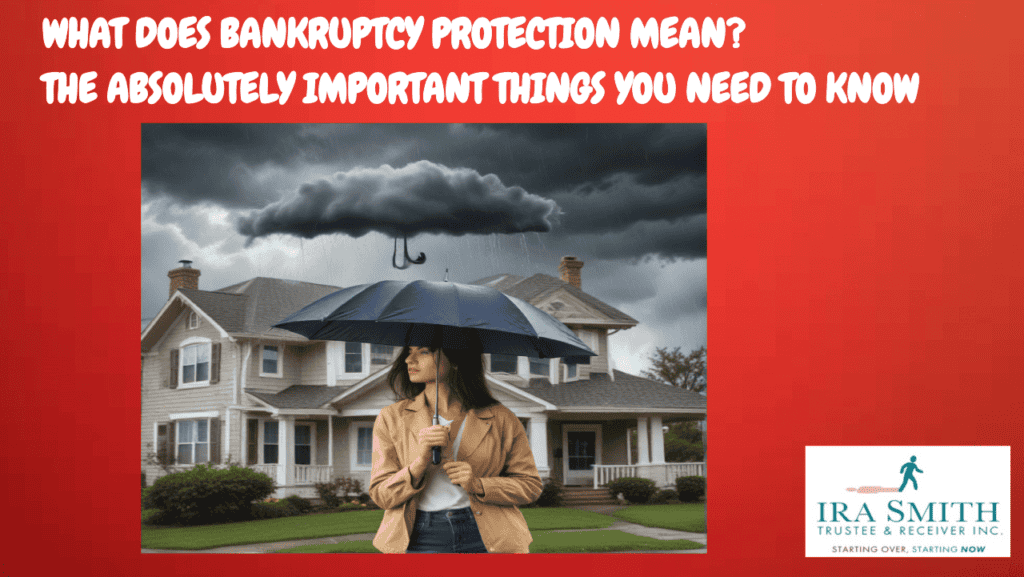
What Does Bankruptcy Protection Mean? Types of Bankruptcy Protection
The BIA is a federal law that covers bankruptcy protection. Provincial laws determine which assets you can keep when filing for bankruptcy. Here are the main types of bankruptcy protection in Canada:
Canadian Liquidation Bankruptcy (known in the United States as a Chapter 7 bankruptcy)
This is a legal process available to both companies and individuals. The company or the person declares themselves unable to repay your debts when filing an assignment in bankruptcy. This results in a stay of proceedings that prevents creditors from taking action against you or your property. A licensed insolvency trustee will be appointed to manage your bankruptcy.
The bankrupt person or company may be required to surrender some assets to the Trustee, who will then sell them and distribute the funds to your creditors. However, for individuals, certain assets are protected under provincial law. For a first-time bankrupt person with no surplus income, you will be discharged from bankruptcy, usually within nine months, after which your debts will be wiped out, with limited exceptions.
Consumer Proposal (known in the United States as a Chapter 13 bankruptcy)
A consumer proposal is a financial restructuring bankruptcy alternative for people who owe $250,000 or less, other than for any debts registered against your principal residence. In a consumer proposal, you offer your creditors a partial repayment of your debt through a licensed insolvency trustee. If your creditors accept the proposal, your debts are consolidated into one settlement, and you make payments over some time, typically up to five years. Your assets are not affected by a consumer proposal, and you are protected from creditor actions while the proposal is in effect.
Commercial Proposal (known in the United States as a Chapter 11 bankruptcy)
Companies, or people who owe more than $250,000, can get bankruptcy protection, restructure their finances and avoid bankruptcy through the commercial proposal section of the BIA.
Restructuring under the Companies’ Creditors Arrangement Act (this is the closest we have to a US Chapter 11 bankruptcy protection filing)
Companies that owe $5 million or more, can gain bankruptcy protection and restructure their operations and finances using federal legislation called the Companies’ Creditors Arrangement Act.
All of the above bankruptcy protection alternatives require a licensed insolvency trustee to administer the process.
What Does Bankruptcy Protection Mean? Key Concepts of Bankruptcy Protection
Automatic Stay
What is a stay of proceedings and how does it work? A stay of proceedings is a legal measure triggered by filing for bankruptcy or a Consumer Proposal for financial restructuring. It immediately halts all creditor actions against you, including collection calls, legal proceedings, and asset seizures. This provides relief from creditor harassment and safeguards your assets and income while navigating the process.
Debt Restructuring through bankruptcy or consumer proposal
Two primary methods for debt restructuring in Canada are bankruptcy and consumer proposals. People understand how consumer proposals are for debt restructuring because that is exactly what it does. But how can personal bankruptcy be a debt restructuring tool?
Both options provide legal protection from creditors and offer a path toward financial stability.
Bankruptcy process
Filing for bankruptcy initiates a legal process and invokes the stay of proceedings. That halts all creditor actions, including collection calls, lawsuits, and wage garnishments. This protection extends to most creditors, including government agencies like the Canada Revenue Agency, with a few exceptions, like family support payments.
A common misconception is that bankruptcy leads to the loss of all assets. However, there are provincial laws in Canada that intersect with federal bankruptcy laws. One such provincial statute is the Ontario Execution Act, R.S.O. 1990, c. E.24, which designates certain assets as “exempt”. These exempt assets, based on liquidation value, not original cost, are protected during bankruptcy and can include:
- Household furnishings and appliances – $13,150
- Equity in a vehicle – $6,600
- Home equity up to $10,000
- RRSPs, other than for contributions made in the 12 months before filing bankruptcy
- Medical aids and devices that are required to assist with a disability or a medical or dental condition
- Cash surrender value of life insurance policies where a spouse or family member is an irrevocable designated beneficiary
Even if an asset exceeds the exemption limit, options exist to retain it. These options include repurchasing the asset by paying the non-exempt value into the bankruptcy estate or including that value in calculating what you need to pay for a successful consumer proposal instead.
To file for bankruptcy, you need to owe at least $1,000. You need debts to file; it doesn’t require any assets or income to be eligible! Individuals with minimal or no assets can still file for bankruptcy and benefit from its protections.
Consumer Proposal
A consumer proposal is a formal arrangement between a debtor and their creditors, arranged through a licensed insolvency trustee. This option helps debtors combine their debts and propose to repay creditors a portion of what they owe, typically between 20% and 50% of the total debt.
Consumer proposals offer several advantages:○
- You do not lose your assets, making it suitable for those with significant non-exempt assets.
- Interest charges stop accruing.
- Creditors are legally prevented from starting or pursuing further collection actions due to the “stay of proceedings”.
- Although a consumer proposal isn’t technically bankruptcy, it provides similar legal protections and debt relief benefits.
Both bankruptcy and consumer proposals are complex legal processes. Consulting with a licensed insolvency trustee, the only professional authorized to administer these proceedings is crucial to determine the most suitable option for individual circumstances. We can assess your financial situation, explain the implications of each choice, and guide you through the process.

What Does Bankruptcy Protection Mean? Rights and Responsibilities of Debtors
Rights of Debtors:
- Stay of Proceedings
- Asset Protection
- Options For Non-Exempt Assets
- Income Protection: Bankruptcy shields debtors’ income from most creditors, protecting them from wage garnishments and bank account seizures. This includes protection from the CRA. There are some specific cases where income protection is not available, such as ongoing child or spousal support payments.
- Eligibility Regardless of Assets or Income
- Consumer Proposals as an Alternative: Consumer proposals provide a bankruptcy alternative, allowing debtors to consolidate debts and negotiate a reduced repayment plan with their creditors10. While offering similar creditor protection through a stay of proceedings, consumer proposals do not impact assets, making them attractive for individuals with significant non-exempt equity.
Responsibilities of Debtors:
While the sources primarily focus on the rights and protections offered by bankruptcy and consumer proposals, there are certain inherent responsibilities:
- Full Disclosure: Debtors are obligated to provide accurate and complete financial information to their licensed insolvency trustee, including all assets, debts, income, and expenses.
- Cooperation: Debtors must cooperate with their Trustee throughout the bankruptcy or proposal process, attending meetings, providing requested documentation, and adhering to the terms of their agreement.
- Compliance with Legal Requirements: Debtors must fulfill the specific legal requirements of their chosen debt relief solution, which may include attending financial counselling sessions or making agreed-upon payments.
Choosing the Right Path
Deciding between bankruptcy and a consumer proposal requires careful consideration with the guidance of a licensed insolvency trustee. The Trustee’s expertise helps determine the most suitable option based on individual circumstances, ensuring debtors understand their rights and obligations.
What Does Bankruptcy Protection Mean? The Role of Bankruptcy Courts
In Canada, bankruptcy courts play a crucial role in the administration of bankruptcy and insolvency proceedings. Here are some key responsibilities of bankruptcy courts in Canada:
- Hearing Bankruptcy Applications: Bankruptcy courts hear petitions filed by individuals or businesses seeking to be declared bankrupt be it personal or business bankruptcy. The court determines whether the applicant is eligible to be declared bankrupt and whether the petition is valid.
- Approving Reorganization Plans: In cases where a company is seeking to restructure its debt through BIA or CCAA reorganization plans, the bankruptcy court must approve the plan. The court ensures that the plan is fair and reasonable and that it provides for the payment of creditors in a timely manner.
- Approving Asset Sales: Bankruptcy courts have the authority to approve asset sales conducted by the Trustee. This ensures that the sales are conducted fairly and reasonably and that the assets are sold for a fair price under the circumstances.
- Hearing Creditors Appealing the Trustee’s Disallowance of Their Claim: Bankruptcy courts hear appeals of claim disallowances against the bankrupt’s estate. The court determines if the Trustee’s decision on the validity and priority of each claim is correct or not if appealed.
- Approving Settlements: Bankruptcy courts can approve settlements between the Trustee and creditors, ensuring that the settlement is fair and reasonable.
- Overseeing the Administration of the Bankrupt’s Estate: Bankruptcy courts monitor the administration of the bankrupt’s estate, ensuring that the Trustee is performing their duties following the BIA and that the estate is being managed fairly and reasonably.
- Making Rulings on Disputes: Bankruptcy courts make rulings on disputes that arise during the bankruptcy process, such as disputes between the Trustee and creditors, or between creditors themselves.
- Providing Guidance: Bankruptcy courts can guide the Trustee, creditors, and other stakeholders on the interpretation and application of the BIA and other relevant laws in response to such a motion.
- Bankrupt’s opposed discharges: The Court hears all opposed applications for discharge of the bankrupt person and rules on what kind of discharge the person is entitled to.
What Does Bankruptcy Protection Mean? The Role of the Office of the Superintendent of Bankruptcy Canada
The Office of the Superintendent of Bankruptcy Canada (OSB) is a federal agency that manages bankruptcy and insolvency proceedings across the country. The OSB is essential for enforcing the BIA and making sure the insolvency system runs smoothly and fairly. Here are some of the main responsibilities of the OSB:
- Regulation and Oversight: The OSB regulates and oversees the activities of trustees, receivers, and other insolvency professionals to ensure that they comply with the BIA and other relevant laws.
- Licensing and Registration: The OSB licenses and registers trustees, receivers, and other insolvency professionals, ensuring that they meet the necessary qualifications and standards.
- Monitoring and Investigation: The OSB monitors and investigates complaints and concerns related to the administration of bankruptcy and insolvency proceedings, including allegations of misconduct or fraud.
- Enforcement: The OSB enforces the BIA and other relevant laws, including issuing warnings, fines, and penalties to individuals and companies that violate the law.
- Guidance and Education: The OSB provides guidance and education to stakeholders, including trustees, creditors, and debtors, on the BIA and other relevant laws and regulations.
- Research and Analysis: The OSB conducts research and analysis on insolvency trends, statistics, and best practices, which help inform policy decisions and improve the effectiveness of the insolvency system.
- Policy Development: The OSB develops and recommends policies to the Minister of Justice and Attorney General of Canada, which helps shape the direction of the insolvency system.
- Public Education: The OSB provides public education and awareness campaigns to inform Canadians about the insolvency system, the consequences of bankruptcy, and the importance of financial literacy.
- Collaboration with Other Agencies: The OSB works closely with other government agencies, such as the CRA and the Financial Consumer Agency of Canada (FCAC), to ensure a coordinated approach to insolvency and debt management.
- Reporting and Accountability: The OSB is responsible to Parliament and reports directly to the Minister of Justice and Attorney General of Canada. This structure ensures transparency and accountability in its operations and decisions.
In summary, the OSB is essential for maintaining the integrity and efficiency of Canada’s insolvency system and safeguarding the rights of creditors, debtors, and other parties involved.
What Does Bankruptcy Protection Mean? Impacts of Bankruptcy Protection
Financial Relief for Debtors
Bankruptcy provides an opportunity for debt relief. While it does not require the debtor to have any assets, it might involve surrendering non-exempt assets to the bankruptcy estate. However, debtors can explore options like a family member repurchasing assets by paying the non-exempt value or filing a Consumer Proposal, which allows for debt consolidation and partial repayment to creditors without surrendering assets.
Bankruptcy allows individuals and businesses struggling with debt to restructure or eliminate their debts and rebuild a stable financial future. After the personal bankruptcy process, debtors receive a discharge, typically within nine months for a first-time bankrupt person, marking the end of their bankruptcy and the elimination of eligible debts. In corporate bankruptcies, there is not a discharge process.
Effects on Credit Scores
Filing for bankruptcy becomes a matter of public record and is reported to credit bureaus. This information remains on your credit report for a significant period, typically six to seven years in Canada, though this can vary based on provincial laws and the type of bankruptcy protection filed. This negative mark on your credit history will likely result in a significant drop in your credit score.
Lenders use credit scores to assess the risk associated with lending money. A low credit score resulting from bankruptcy makes it difficult to obtain new credit, such as loans, credit cards, or mortgages. Even if you do qualify for credit, you may face less favourable terms, including higher interest rates and lower credit limits.
While not directly related to credit scores, bankruptcy can impact other aspects of your financial life. For instance, some employers and landlords may consider credit history when making hiring or rental decisions.

What Does Bankruptcy Protection Mean FAQ
Here is our what does bankruptcy protection mean FAQ:
- What does “Bankruptcy Protection” mean? Bankruptcy protection refers to the legal safeguards provided to individuals or companies when they file for bankruptcy. It essentially halts all debt collection activities, legal actions, and wage garnishments by creditors. This protection is activated through an “automatic stay” upon filing for bankruptcy.
- What does Bankruptcy Protection protect? Bankruptcy protection is designed to help you keep your assets safe from creditors. It provides a legal way to either reorganize your finances or sell off assets in an orderly fashion under court oversight. Many people think that filing for bankruptcy means you have to give up everything, but that’s not the case. Some laws allow you to keep important items such as your home, car, and personal possessions.
- How does the automatic stay work? The automatic stay is a court order that takes effect immediately upon filing for bankruptcy. It acts as a legal shield, prohibiting creditors from taking any further action to collect debts incurred before the bankruptcy filing. This includes stopping lawsuits, wage garnishments, bank account freezes, and even harassing phone calls.
- Does filing for bankruptcy mean I will lose all my assets? Not necessarily. While bankruptcy may involve liquidating some assets to repay creditors, the bankruptcy code provides exemptions that allow you to keep certain assets deemed necessary for your livelihood. These exemptions vary by state but generally include a homestead exemption for your primary residence, a vehicle exemption, and exemptions for personal property like clothing, furniture, and tools needed for your profession.
- How does bankruptcy protection help me keep my assets? Bankruptcy protection helps preserve your assets in two primary ways:
- Automatic Stay: It prevents creditors from seizing your assets while you reorganize your finances or create a repayment plan. Exemptions: These legal provisions shield specific assets from liquidation, ensuring you retain essential possessions.
- What is the difference between Bankruptcy and a Consumer Proposal? Bankruptcy means selling off non-exempt assets to repay creditors. It’s generally an option for individuals or businesses that are struggling with low income and limited assets. On the other hand, a consumer proposal is a way for individuals with a steady income to suggest a repayment plan to their creditors that lasts up to five years. This option lets you keep your assets while getting rid of your debt.
- How can I learn more about bankruptcy protection and whether it’s right for me? If you’re looking to learn more about bankruptcy protection and whether it’s the right choice for you, it’s important to talk to a licensed insolvency trustee. They can provide insights tailored to your financial situation, explain the various bankruptcy options available, clarify how it might affect your assets, and help you navigate the legal steps involved.
- What are some misconceptions about bankruptcy? You will lose everything: While some assets may be liquidated, exemptions exist to protect essential belongings. It will ruin your credit forever: While bankruptcy negatively impacts credit scores, it is possible to rebuild credit over time with responsible financial management. It is a mark of shame: Bankruptcy is a legal process designed to provide individuals and businesses with a fresh financial start.
What Does Bankruptcy Protection Mean Conclusion
Navigating the world of bankruptcy protection can feel daunting, but fear not! It’s a valuable safety net designed to help both individuals and businesses get back on their feet during tough financial times. Think of it as a wonderful opportunity to reorganize debts and embrace a fresh start.
By familiarizing yourself with the different types of bankruptcy, understanding the implications of filing, and discovering how it may affect your credit score, you’ll be well-equipped to make smart choices for your financial future. While bankruptcy isn’t the perfect fit for everyone, it can truly be a lifesaver for those in need of a financial reboot. So take a deep breath and explore your options—you’ve got this!
I hope you enjoyed this what does bankruptcy protection mean Brandon’s Blog. Do you or your company have too much debt? Are you or your company in need of financial restructuring due to distressed real estate or other reasons? The financial restructuring process is complex. The Ira Smith Team understands how to do a complex restructuring. However, more importantly, we understand the needs of the entrepreneur or someone with too much personal debt.
You are worried because you are facing significant financial challenges. It is not your fault that you are in this situation. You have been only shown the old ways that do not work anymore. The Ira Smith Team uses new modern ways to get you out of your debt troubles while avoiding the bankruptcy process. We can get you debt relief freedom using processes that are a bankruptcy alternative.
The stress placed upon you is huge. We understand your pain points. We look at your entire situation and devise a strategy that is as unique as you and your problems; financial and emotional. The way we take the load off of your shoulders and devise a plan, we know that we can help you.
We know that people facing financial problems need a realistic lifeline. There is no “one solution fits all” approach with the Ira Smith Team.
That is why we can develop a restructuring process as unique as the financial problems and pain you are facing. If any of this sounds familiar to you and you are serious about finding a solution, contact the Ira Smith Trustee & Receiver Inc. team today.
Call us now for a free consultation. We will get you or your company back on the road to healthy stress-free operations and recover from the pain points in your life, Starting Over, Starting Now.
The information provided in this Brandon’s Blog is intended for educational purposes only. It is not intended to constitute legal, financial, or professional advice. Readers are encouraged to seek professional advice regarding their specific situations. The content of this Brandon’s Blog should not be relied upon as a substitute for professional guidance or consultation. The author, Ira Smith Trustee & Receiver Inc. as well as any contributors to this Brandon’s Blog, do not assume any liability for any loss or damage resulting from reliance on the information provided herein.
